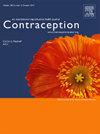特拉华州标题X诊所患者对长效可逆避孕药的认知差异。
IF 2.3
2区 医学
Q1 OBSTETRICS & GYNECOLOGY
引用次数: 0
摘要
目的:我们研究了在报告使用LARCs的患者中是否存在种族/民族和保险状况差异,以及这些差异是否因提供者信任和生育问题而减弱。研究设计:我们分析了来自重复横断面患者调查的两波数据,该调查旨在捕获特拉华州第X条患者健康遭遇的代表性样本(N=797),该调查是在一项大型研究的背景下进行的,该研究旨在评估全州范围内的干预措施,以改善患者获得高效避孕方法的机会。结果:我们发现,大多数患者报告与使用LARCs的想法相关的解脱感,并因种族/民族和保险状况而异。通过对可逆性问题、生育问题和患者-提供者信任进行调整,保险覆盖范围的差异有所减弱,但种族/民族差异仍然存在。59% (95% CI = 55%-63%)的黑人受访者表示对LARC的想法感到宽慰,而白人和西班牙裔/拉丁裔患者分别为67% (95% CI = 63%-71%)和65% (95% CI = 62%-67%)。不相信医生会按要求取出宫内节育器的患者在看LARC时感到宽慰的预测概率为50% (95% CI = 43%-57%),而相信医生会这样做的患者的预测概率为70% (95% CI = 64%-76%)。结论:本研究通过进一步阐明在医疗保健环境中感知代理约束的背景下如何做出有关避孕使用的决定,从而有助于生殖自主研究的不断发展。本文章由计算机程序翻译,如有差异,请以英文原文为准。
Disparities in perceptions of long-acting reversible contraceptives among patients in Delaware Title X clinics
Objectives
We examined whether there were racial/ethnic and insurance status differences in patients reporting a sense of relief with the idea of using long-acting reversible contraceptives (LARCs) and whether these differences were attenuated by provider trust and fertility concerns among Title X patients.
Study design
We analyzed two waves of data from a repeated cross-sectional patient survey designed to capture a representative sample of Title X patient health encounters in Delaware (N = 797), fielded in the context of a larger study designed to evaluate a statewide intervention to improve patient access to highly effective contraceptive methods.
Results
We found that a majority of patients reported a sense of relief associated with the idea of using LARCs and differences by race/ethnicity and insurance status. Insurance coverage differences were attenuated by adjusting for reversibility concerns, fertility concerns, and patient-provider trust, but racial/ethnic disparities remained. Fifty-nine percent (95% CI, 55%–63%) of Black respondents reported a sense of relief at the idea of having an LARC, compared with 67% (95% CI, 63%–71%) and 65% (95% CI, 62%–67%) of White and Hispanic/Latinx patients, respectively. Patients who did not trust their provider to remove an IUD on request had a predicted probability of 50% (95% CI, 43%–57%) of viewing LARC with a sense of relief compared with 70% (95% CI, 64%–76%) of patients who reported trust in their provider to do so.
Conclusions
This study contributes to the growing body of research on reproductive autonomy by shedding further light on how decisions regarding contraceptive usage are made in the context of perceived agency constraints in health care settings.
Implications
This study underscores the importance of efforts to improve equitable access to long-acting reversible contraceptives by promoting patient-provider trust, addressing patient concerns regarding the short- and long-term effects of LARCs, and ensuring patients have continued access to healthcare treatment.
求助全文
通过发布文献求助,成功后即可免费获取论文全文。
去求助
来源期刊

Contraception
医学-妇产科学
CiteScore
4.70
自引率
17.20%
发文量
211
审稿时长
69 days
期刊介绍:
Contraception has an open access mirror journal Contraception: X, sharing the same aims and scope, editorial team, submission system and rigorous peer review.
The journal Contraception wishes to advance reproductive health through the rapid publication of the best and most interesting new scholarship regarding contraception and related fields such as abortion. The journal welcomes manuscripts from investigators working in the laboratory, clinical and social sciences, as well as public health and health professions education.
 求助内容:
求助内容: 应助结果提醒方式:
应助结果提醒方式:


